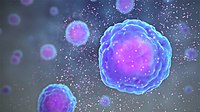
Photo from wikipedia
Pseudorabies virus (PRV), the causative agent of Aujeszky's disease, is one of the most harmful pathogens to the pig industry. PRV can infect and kill a variety of mammals. Nevertheless,… Click to show full abstract
Pseudorabies virus (PRV), the causative agent of Aujeszky's disease, is one of the most harmful pathogens to the pig industry. PRV can infect and kill a variety of mammals. Nevertheless, the underlying pathogenesis related to PRV is still unclear. This study aims to investigate the pathogenesis induced by PRV in a mouse model. The mice infected with the PRV-HLJ strain developed severe clinical manifestations at 36 h post-infection (hpi), and mortality occurred within 48–72 hpi. Hematoxylin-eosin staining and qRT-PCR methods were used to detect the pathological damage and expression of cytokines related to an immune reaction in brain tissue, respectively. The cytokine storms caused by IFN-α, IFN-β, TNF-α, IL-1β, IL-6 and IL-18 were related to the histopathological changes induced by PRV. This pattern of cytokine secretion depicts an image of typical cytokine storms, characterized by dysregulated secretion of pro-inflammatory cytokines and imbalanced pro-inflammatory and anti-inflammatory responses. In addition, the pyroptosis pathway was also activated by PRV by elevating the expression levels of nod-like receptor protein 3, Caspase-1, Gasdermin-D and interleukin-1β/18. These findings provide a way for further understanding the molecular basis in PRV pathogenesis.
Journal Title: Royal Society Open Science
Year Published: 2021
Link to full text (if available)
Share on Social Media: Sign Up to like & get
recommendations!